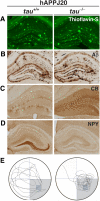Epilepsy and cognitive impairments in Alzheimer disease
- PMID: 19204149
- PMCID: PMC2812914
- DOI: 10.1001/archneurol.2009.15
Epilepsy and cognitive impairments in Alzheimer disease
Abstract
Alzheimer disease (AD) is associated with cognitive decline and increased incidence of seizures. Seizure activity in AD has been widely interpreted as a secondary process resulting from advanced stages of neurodegeneration, perhaps in combination with other age-related factors. However, recent findings in animal models of AD have challenged this notion, raising the possibility that aberrant excitatory neuronal activity represents a primary upstream mechanism that may contribute to cognitive deficits in these models. The following observations suggest that such activity may play a similar role in humans with AD: (1) patients with sporadic AD have an increased incidence of seizures that appears to be independent of disease stage and highest in cases with early onset; (2) seizures are part of the natural history of many pedigrees with autosomal dominant early-onset AD, including those with mutations in presenilin-1, presenilin-2, or the amyloid precursor protein, or with duplications of wild-type amyloid precursor protein; (3) inheritance of the major known genetic risk factor for AD, apolipoprotein E4, is associated with subclinical epileptiform activity in carriers without dementia; and (4) some cases of episodic amnestic wandering and disorientation in AD are associated with epileptiform activity and can be prevented with antiepileptic drugs. Here we review recent experimental data demonstrating that high levels of beta-amyloid in the brain can cause epileptiform activity and cognitive deficits in transgenic mouse models of AD. We conclude that beta-amyloid peptides may contribute to cognitive decline in AD by eliciting similar aberrant neuronal activity in humans and discuss potential clinical and therapeutic implications of this hypothesis.
Figures



References
-
- Snider BJ, Norton J, Coats MA, et al. Novel presenilin 1 mutation (S170F) causing Alzheimer disease with Lewy bodies in the third decade of life. Arch Neurol. 2005;62(12):1821–1830. - PubMed
-
- Amatniek JC, Hauser WA, DelCastillo-Castaneda C, et al. Incidence and predictors of seizures in patients with Alzheimer's disease. Epilepsia. 2006;47(5):867–872. - PubMed
-
- Cabrejo L, Guyant-Maréchal L, Laquerriére A, et al. Phenotype associated with APP duplication in five families. Brain. 2006;129(pt 11):2966–2976. - PubMed
-
- Roberson ED, Scearce-Levie K, Palop JJ, et al. Reducing endogenous tau ameliorates amyloid β-induced deficits in an Alzheimer's disease mouse model. Science. 2007;316(5825):750–754. - PubMed
Publication types
MeSH terms
Substances
Grants and funding
LinkOut - more resources
Full Text Sources
Other Literature Sources
Medical

